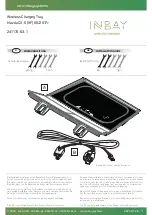
186 STARTING AND OPERATING
Recommended Tire Inflation Pressure
The tire inflation pressure (including the spare wheel)
should be checked regularly and adjusted as well as
inspecting for signs of tire wear or visible damage. Use
a good quality pocket-type gauge to check tire inflation
pressure.
Do not make a visual judgement when determining
proper inflation. Radial tires may look properly
inflated even when they are underinflated.
The tire inflation pressure should be checked
regularly, i.e. at least each time you refuel the vehicle,
and should only be adjusted on cold tires. The
preferred interval for checking the tire inflation
pressure, however, is before each trip.
The tires can be considered cold if the vehicle has been
parked for at least 3 hours or driven less than 1 mile
(1.6 km) at an ambient temperature of approximately
68 °F (20 °C).
Follow recommended cold tire inflation pressures
listed on Tire and Loading Information placard on the
driver’s door B-pillar.
Keeping the tires properly inflated provides the best
handling, tread life and riding comfort.
The pressure difference between the tires on a single
axle should not exceed 1.5 psi (10 kPa).
WARNING!
Avoid spinning of one drive wheel. This may
cause serious damage to the drivetrain which is
not covered by the Warranty.
WARNING!
Follow recommended tire inflation pressures.
Do not underinflate tires. Underinflated tires
wear excessively and/or unevenly, adversely
affect handling and fuel economy, and are more
likely to fail from being overheated.
Do not overinflate tires. Overinflated tires can
adversely affect handling and ride comfort, wear
unevenly, increase stopping distance, and result
in sudden deflation (blowout) because they are
more likely to become punctured or damaged by
road debris, potholes etc.
Summary of Contents for 2006 Freightliner
Page 2: ......
Page 56: ......
Page 88: ......
Page 91: ...UNDERSTANDING YOUR INSTRUMENT PANEL 91 4 INSTRUMENTS AND CONTROLS...
Page 93: ...UNDERSTANDING YOUR INSTRUMENT PANEL 93 4 INSTRUMENT CLUSTER AND INDICATOR LAMPS...
Page 110: ...110 UNDERSTANDING YOUR INSTRUMENT PANEL SWITCH LOCATIONS...
Page 250: ......
Page 253: ...MAINTAINING YOUR VEHICLE 253 7 ENGINE COMPARTMENT...
Page 278: ...278 MAINTAINING YOUR VEHICLE Position of fuses and relays Fuses 4 Relays 5...
Page 279: ...MAINTAINING YOUR VEHICLE 279 7 Fuse Assignment Standard Equipment...
Page 282: ...282 MAINTAINING YOUR VEHICLE Fuse Relay and Diode Assignments Optional Equipment...
Page 302: ......
Page 316: ......
Page 330: ......
















































